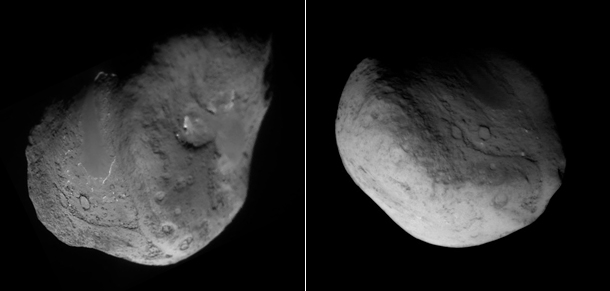Man-made crater on Comet Tempel 1

Images of comet Tempel 1, from Deep Impact (left) and Stardust-Next (right).
Image credit: NASA/JPL-Caltech/Cornell; NASA/JPL-Caltech/UMD
Image credit: NASA/JPL-Caltech/Cornell; NASA/JPL-Caltech/UMD
In July 2005, a NASA spacecraft called Deep Impact intercepted comet Tempel 1 and shot at it. The 370 kg lump of copper that was fired at the comet hit at a speed of just over 10 kilometers per second – about 30 times the speed of sound on Earth. The resulting explosion threw up a plume of debris which Deep Impact’s instruments were able to study, providing valuable data for mission scientists back on Earth. The plume obscured the surface of the comet, though, making it impossible to see the impact crater until earlier this week, on St Valentine’s Day.
An earlier mission, Stardust, was halfway home from a similar mission when Deep Impact fired its projectile. Stardust was launched way back in 1999, and had a complicated mission in which is collected samples of space dust, visited asteroid AnneFrank in 2002, and studied comet Wild 2 in 2004. The final leg of the mission was to fly by Earth, dropping off its various sample cannisters.
Stardust mission engineers then reconfigured the probe, giving it a new mission: Stardust-Next. In this mission, it would change course to intercept comet Tempel 1 and attempt to take images of the comet’s surface. These images would not only show us what the Deep Impact crater looked like (which would provide valuable information about the structure and density of the comet), but also provide a surface map which could be compared with the images from the Deep Impact mission. The comparison would reveal just how the comet had been changed by it’s last encounter with the Sun.
The encounter was a major success, returning imagery far exceeding anybody’s expectations. As well as completing all the mission goals, including finding the impact crater, it has returned a wealth of data which will keep mission scientists very busy for a long time.
